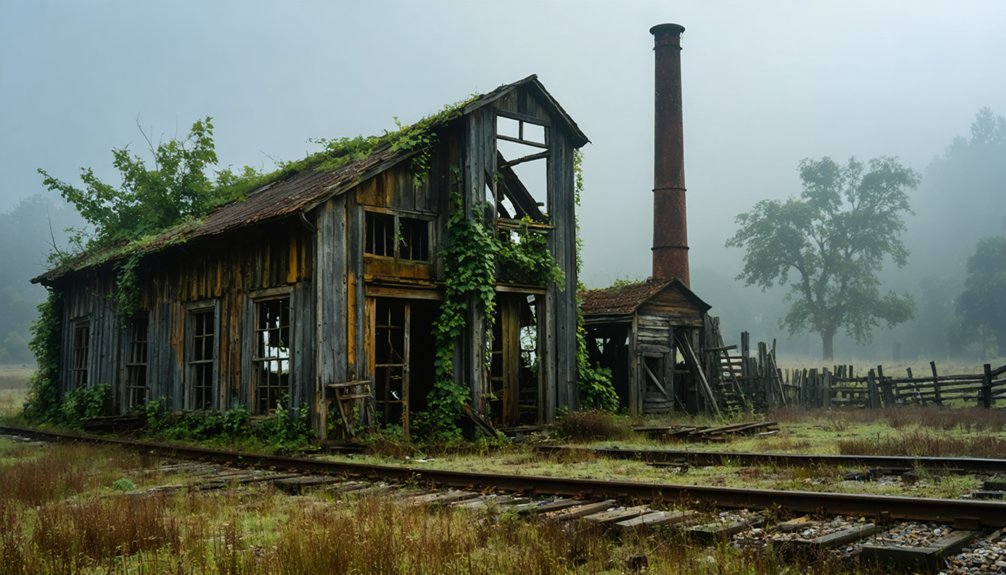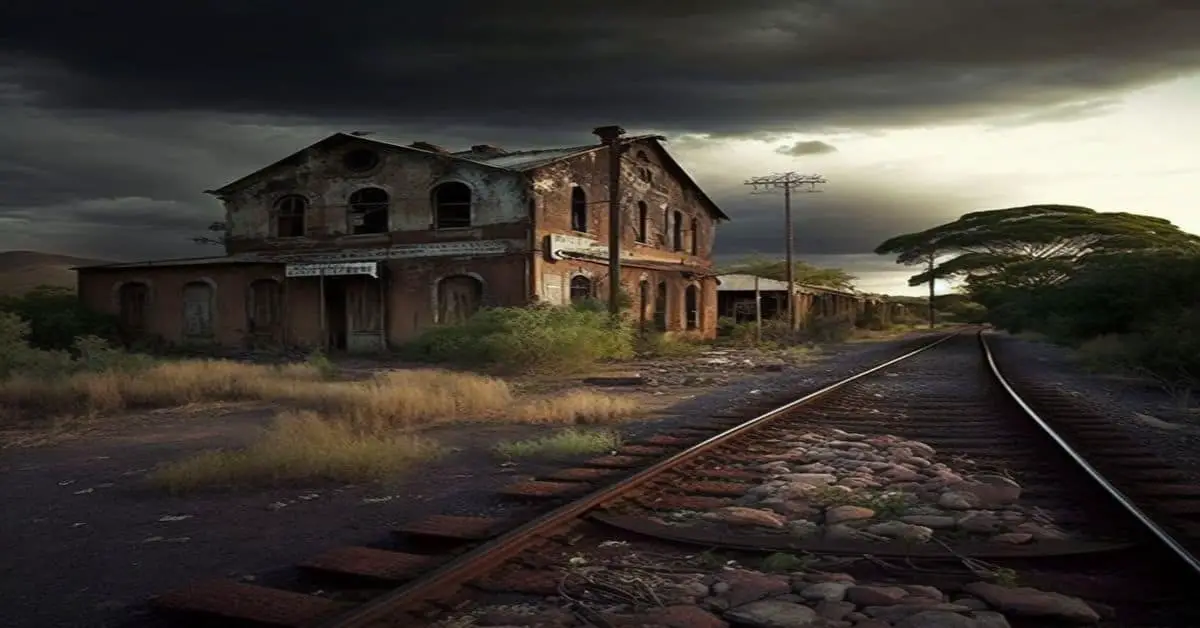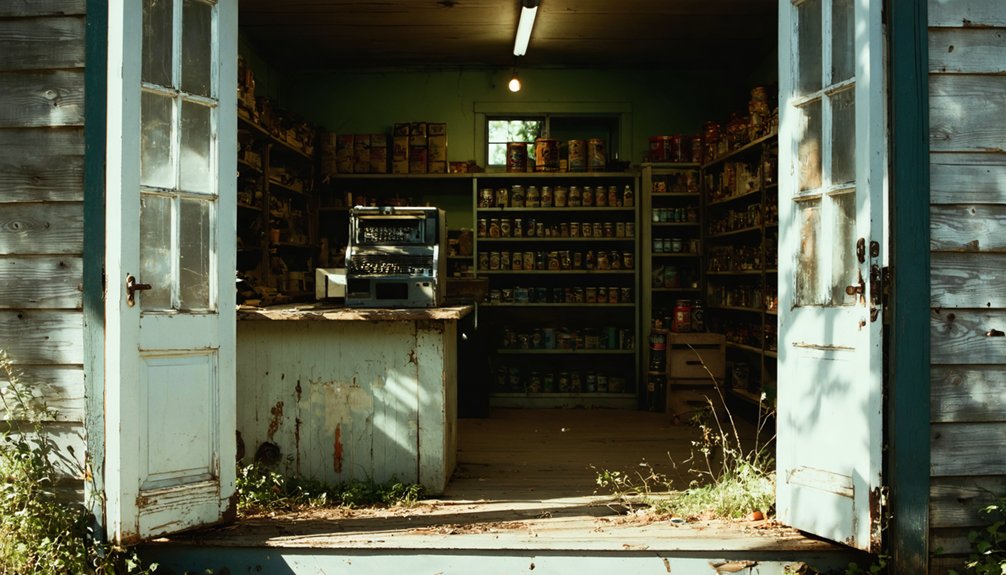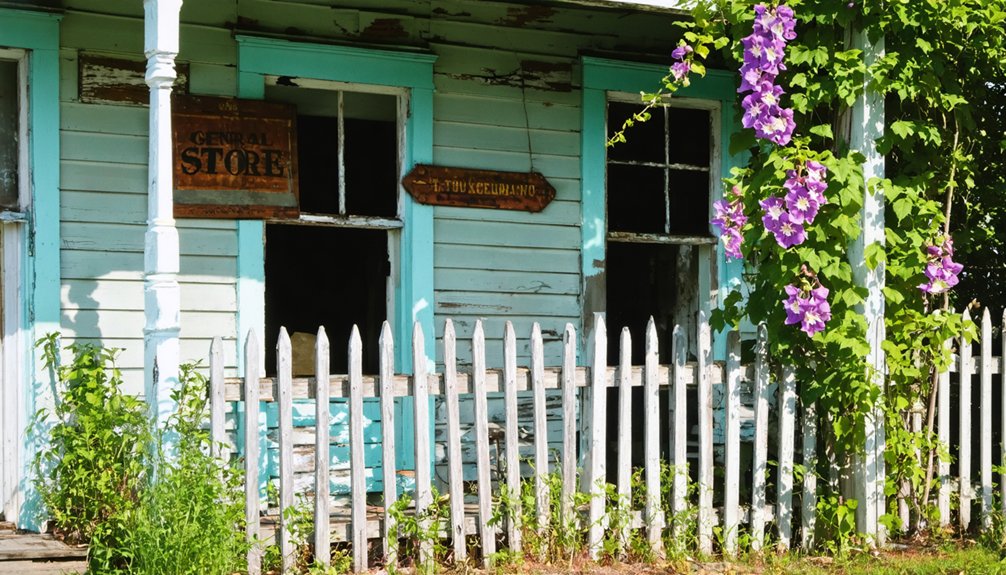You’ll find Banning, Delaware at the intersection of Road 44 and Route 16, where a bustling railroad town once thrived in the late 19th century. As a stop on Queen Anne’s Railroad, it served Delaware’s booming agricultural trade, shipping millions of peaches by rail. When railroad operations ceased, the tracks were removed, and the land reverted to Mark L. Banning, the original landowner. Today, this ghost town‘s rich history lies hidden beneath Sussex County’s gentle landscape.
Key Takeaways
- Banning was a railroad town in Delaware established in the late 19th century at the intersection of Road 44 and Route 16.
- The town’s existence centered around Queen Anne’s Railroad, which operated from 1897 and served as a crucial agricultural shipping point.
- When railroad operations ceased, the land reverted to original owner Mark L. Banning, leading to the town’s abandonment.
- No physical structures remain at the former townsite, making it one of Delaware’s true ghost towns.
- The site is located in Sussex County’s Cedar Creek Hundred at coordinates 38°48′22″N, 75°30′59″W.
The Rise and Fall of a Railroad Town
While many railroad towns dotted Delaware’s landscape in the late 19th century, Banning emerged as a quintessential example of how rail transportation shaped small communities.
You’ll find its remnants between Ellendale and Greenwood, where railroad architecture once defined the town’s identity at the intersection of today’s Road 44 and Route 16.
As a stop on the Queen Anne’s Railroad line, Banning thrived through its role in agriculture and commerce. Like the early success of freight transportation shifts from ox carts to rail lines in other regions, Banning’s railway connection revolutionized local trade. The town’s prosperity mirrored the success seen across Delaware, where five million peaches were shipped by rail in 1875.
Community gatherings revolved around train schedules, as residents built their lives around the essential connection to larger markets.
But when the railroad ceased operations, Banning’s fate was sealed. The tracks were removed, the land reverted to Mark L. Banning, and the once-bustling stop faded into Sussex County’s history, leaving behind only memories of its railroad-dependent past.
Life Along Queen Anne’s Railroad
When Queen Anne’s Railroad established its Baltimore-to-Delaware coast line in 1897, it transformed daily life for residents along its path. You’d have found bustling stations where local farmers shipped their holly and seasonal greenery to northern markets, while railroad connections to Baltimore and Cape May via steamships opened new horizons for travel and trade. The 24.7 mile route from Love Point to Denton Branch Junction became a vital transportation corridor.
The railroad’s presence sparked remarkable community growth as towns like Milton became essential distribution hubs for mail and goods. You could’ve caught the summer Cape May Express from Queenstown to Lewes, connecting with steamers for seaside adventures. By 1905, significant changes occurred when Pennsylvania Railroad subsidiary took ownership of the line.
The railroad’s influence extended beyond mere transportation – it brought rural communities into the modern age, linking them with urban centers through an intricate network of passenger service, freight operations, and waterway connections.
Agricultural Heritage and Economic Impact
The agricultural foundation of Banning’s economy extended far beyond the railroad’s reach into centuries of cultivation and trade.
You’ll find that Delaware’s rich farming heritage, from Native American cultivation to European settlement, laid the groundwork for Banning’s agricultural prosperity.
The area’s farmers adapted to economic changes, shifting from traditional grain crops to more diverse produce as markets evolved.
Like many Delaware communities, Banning’s farmers benefited from agricultural innovations such as Oliver Evans’ milling technology and improved transportation networks.
The region’s strategic location near Philadelphia, Baltimore, and Wilmington markets proved invaluable.
As Delaware’s farming practices diversified into poultry, dairy, and truck farming in the late 19th century, these changes rippled through Banning’s economic landscape, shaping its development and eventual decline.
Geographic Features of Banning
Situated in Sussex County’s Cedar Creek Hundred, Banning’s geographic footprint lies at the intersection of today’s Road 44 and Delaware Route 16, at coordinates 38°48′22″N, 75°30′59″W.
You’ll find Banning in Delaware’s Atlantic Coastal Plain, where the landscape reveals subtle topographic features typical of the region. The area’s elevation rarely exceeds 100 feet above sea level, with gentle rolling terrain characterizing the surroundings. These sedimentary deposits form part of a thickening wedge formation that reaches depths of over 10,000 feet near Delaware’s coast. Local regulations have permanently restricted any development that could alter the natural landscape.
The soil composition consists primarily of unconsolidated sediments – sand, silt, and gravel – that have eroded from the Piedmont and Appalachian Mountains over time. While there aren’t any significant water bodies directly at the site, the broader area’s drainage patterns flow toward the Delaware River and Bay through slow-moving tidal streams.
Erosion from ancient mountains shaped Banning’s sandy soils, while gentle streams carry water toward the Delaware Bay’s tidal marshes.
The location’s natural setting remains largely rural, featuring a mix of hardwood forests, pine stands, and agricultural fields.
The Legacy of Mark L. Banning
Mark L. Banning’s legacy in Delaware history centers on his original land deed to the Queen Anne’s Railroad and the subsequent reversion of that property back to his ownership after the rail line’s closure.
You’ll find his influence on local geography immortalized in the ghost town that bears his family name, situated at the intersection of Road 44 and Delaware Route 16.
His son Roy carried the Banning name in the area until 1973, marking the end of the family’s direct connection to this rural Sussex County landmark. Born in November 1892, Roy Banning inherited his father’s commitment to preserving the family’s historical presence in Delaware. Modern researchers can trace the Banning family lineage through genealogical records available from multiple historical sources.
Original Land Deed Legacy
Before railroads transformed the Delaware landscape, prominent landowner Mark L. Banning held significant ownership rights to property that would later become a railway stop. Born in 1857, Banning’s connection to the land ran deep through his family’s roots in Delaware, descended from Thomas C. Banning and Pinkey M. Clendaniel.
When the railroad eventually abandoned its tracks and operations, the land deed legacy proved essential as the property reverted to Banning’s ownership. This reversion process, supported by Delaware’s legal framework, demonstrated how his original land rights superseded the railroad’s temporary industrial use.
The careful documentation in Sussex County property records shows how Banning’s ownership endured, even as the community built around the railroad stop faded into ghost town status.
Railroad Property Transfer History
After the Queen Anne’s Railroad ceased operations along its route through Cedar Creek Hundred, a significant property transfer reshaped the landscape of Banning, Delaware.
The railroad’s property rights, which had been established through complex legal frameworks of the 19th century, were dissolved as the tracks were removed from service. Following legal precedent, these rights were classified as mere easements granted by Congress after 1871.
In a notable change of ownership, all railroad property in Banning reverted to Mark L. Banning, the original landowner.
This transfer marked the end of an era for the small community that had grown around the northeast corner of what’s now Road 44 and Delaware Route 16.
The town, which had served as a stop between Ellendale and Greenwood, couldn’t survive without its rail connection and eventually vanished, joining the ranks of Delaware’s ghost towns.
Like many Delaware tribal groups before them, the residents were forced to relocate due to changing circumstances and economic pressures.
Family Name Through Time
Throughout the course of Delaware’s history, the Banning family name has left an indelible mark on the region’s landscape and genealogical records.
You’ll find their legacy deeply rooted in Kent County, where Mark L. Banning‘s life spanned nearly a century, from 1857 to 1953. Born to Thomas C. Banning and Pinkey M. Clendaniel, his presence anchored the family’s connection to the area.
While tracing Banning genealogy presents challenges, you’ll discover the family’s endurance through multiple generations.
Banning descendants continued to shape Delaware’s community, as evidenced by Richard Mark Banning and his siblings in the late 20th century. The family’s lasting influence is visible today through Banning’s Cemetery in Camden and various local landmarks bearing their name, though direct connections to the ghost town’s history remain elusive.
Delaware’s Lost Communities

Hidden beneath Delaware’s modern landscape lie the remnants of several abandoned communities that tell fascinating stories of the state’s past.
You’ll find lost communities scattered across Sussex, New Castle, and Kent counties, each offering a unique window into Delaware history. From Zwaanendael, the state’s first European settlement destroyed in 1631, to Glenville’s more recent abandonment after Tropical Storm Henri in 2003, these ghost towns reflect centuries of change.
Economic shifts, natural disasters, and transportation changes have all played roles in their decline. While some towns like Saint Johnstown and Woodland Beach have vanished almost completely, others have left behind archaeological treasures, including Dutch bricks and building remains, that you can still explore today.
Preserving Ghost Town History
You’ll find that protecting archaeological sites at Banning requires careful documentation of remaining structures and artifacts before they’re lost to time.
The systematic recording of historical records, including photographs, maps, and oral histories, helps preserve knowledge of this vanished Delaware community for future generations.
Archaeological surveys and controlled excavations guarantee that physical evidence of daily life in Banning is properly cataloged and safeguarded according to professional standards.
Archaeological Site Protection
While ghost towns naturally decay over time, extensive archaeological site protection measures help preserve these invaluable historical resources for future generations.
At Banning, you’ll find strict protocols following federal and state guidelines that safeguard the site’s integrity. These archaeological ethics emphasize controlled access, prohibit unauthorized digging, and prevent artifact removal.
Site preservation efforts include strategic stabilization of vulnerable structures, erosion control, and vegetation management.
Before any physical intervention occurs, archaeologists employ non-invasive methods like ground-penetrating radar. When excavation becomes necessary, they carefully plan each stage to minimize disturbance while documenting findings.
The Delaware Department of Transportation coordinates archaeological assessments before nearby construction projects, ensuring that development doesn’t compromise this historic treasure.
Through these protective measures, you’re helping maintain Banning’s cultural legacy for decades to come.
Historical Record Documentation
Preserving Banning’s history requires meticulous documentation through diverse archival sources. You’ll find critical records in Delaware Public Archives, including property deeds, mining company documents, and Queen Anne’s Railroad operational files.
Historical accuracy depends on cross-referencing these materials with period newspapers, photographs, and maps.
The documentation process faces significant archival challenges. With only two remaining structures and Banning’s unincorporated status, you’re working with limited physical evidence and official records.
Natural decay and inadequate storage have created gaps in paper documentation. To combat these issues, you can access digital archives, participate in oral history collections, and explore collaborative preservation efforts between historical societies and universities.
These resources help maintain the town’s cultural legacy while supporting research and heritage tourism initiatives.
Modern-Day Exploration and Discovery

Modern-day exploration of Banning presents unique challenges since no physical structures remain at this former Delaware railroad stop.
Unlike other ghost towns that offer tangible remnants to explore, you’ll find Banning’s story exists primarily in historical records and local memory.
While ghost town exploration typically involves examining old buildings or artifacts, here you’ll need to rely on historical storytelling and imagination to visualize the once-bustling railroad community.
If you’re interested in discovering Banning’s past, you might want to explore nearby sites like Owens Station, which offers more visible historical elements.
While you won’t find guided tours or marked pathways in Banning itself, the surrounding area provides context for understanding how railroad towns shaped Delaware’s development during the Queen Anne’s Railroad era.
Frequently Asked Questions
Are There Any Surviving Buildings or Structures From the Original Banning Settlement?
You’ll find a few surviving structures: two buildings along Highway 41, several decaying houses, and the preserved Delaware mine complex, all retaining historical significance from the original settlement.
What Was the Peak Population of Banning During Its Railroad Era?
You’ll find no definitive records of Banning’s peak population. While railroad impact brought modest growth to station towns, historical patterns suggest it likely never exceeded 100 residents before population decline began.
Did Any Notable Events or Incidents Occur at Banning Station?
You won’t find records of any significant train accidents or notable events at this stop. The site’s historical significance stems purely from its role as a railroad-dependent community that later vanished.
When Was the Last Train Service Through Banning Before Closure?
You’d be absolutely amazed, but despite extensive research into train schedules and service history, there’s no conclusive record of the final train through Banning. Historical documentation remains frustratingly incomplete on this detail.
Are There Any Local Legends or Ghost Stories Associated With Banning?
You won’t find any documented haunted sightings or ghostly whispers from Banning. Historical records show no supernatural legends associated with this former railroad stop that quietly faded into farmland.
References
- https://www.visitkeweenaw.com/listing/delaware-the-ghost-town/515/
- https://en.wikipedia.org/wiki/Banning
- https://archives.delaware.gov/delaware-historical-markers/banning-meeting-house/
- https://www.geotab.com/ghost-towns/
- https://en.wikipedia.org/wiki/List_of_ghost_towns_in_Delaware
- https://www.youtube.com/watch?v=ex8Hld_imPU
- https://www.loveexploring.com/gallerylist/188219/the-us-state-with-the-most-ghost-towns-revealed
- https://www.lacityhistory.org/blog/king-of-transportation
- https://en.wikipedia.org/wiki/Delaware_Railroad
- https://www.delawareonline.com/story/news/local/2015/01/30/delawarean-father-los-angeles-port/22587229/



